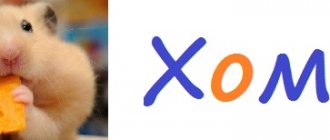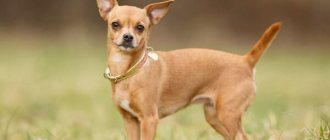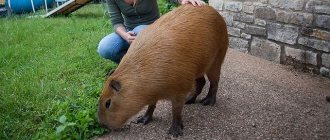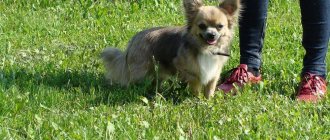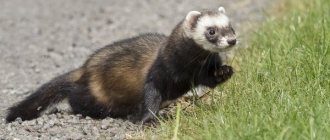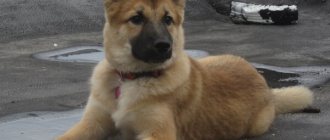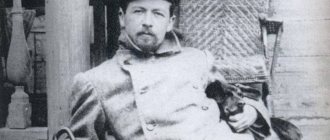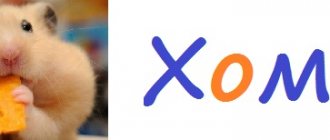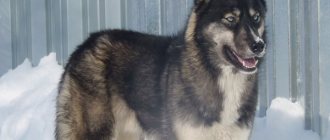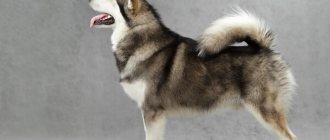What types of hamsters are there? How to distinguish them from each other? What types of hamsters are suitable for keeping at home? You will find answers to these questions in the article.
Let’s make a reservation right away that we will only talk about varieties of hamsters that can be tamed and domesticated. Let's take a quick look at wild rodents.
If you don’t understand breeds, this will grow up.
Dzungarian (aka Sungur)
Baby jungarik.
Yes, this is not a typo - the Dzungarian hamster and the Sungur hamster are the same breed. In common people, the pet is called a dzhungarik after the name of the region in China, its natural habitat. Sungurik - from the scientific name Phodopus sungorus.
Other erroneous names for dwarf hamsters are Siberian hamster and Russian dwarf. Such breeds of pets do not exist in the classification; if they are trying to sell you a Siberian or Russian at an inflated price, find another seller.
Sungursky is a dwarf species, grows up to 10 cm in length and gains a weight of 45-65 grams. The “feet” on the paws are covered with hair. The color on the back is dark, on the belly it is almost white. A characteristic difference is a clearly defined thin dark stripe along the ridge.
The “standard” back color is brown or dark gray. But there are decorative colors:
- Sapphire (gray with a bluish tint);
- Pearl (snow-white);
- Tangerine (similar in color to the golden Syrian).
The Dzhungarik changes its coat color depending on the time of year (lighter in winter), but this rarely happens at home.
The character is perhaps the friendliest among all hamsters. Djungarians often like to be stroked on their backs and bellies; they willingly fall asleep in your arms.
Lives in captivity for an average of 3 years, but with proper care, 4 are possible.
You can house opposite-sex pairs (just keep in mind that they will reproduce quickly and actively). It is better not to keep same-sex Dzungarians together; they do not get along well.
The tiny size leaves an imprint on the maintenance and feeding of the baby. Read about care in detail in this material.
Taylor
Taylor is the most decorative of all types of domestic rodents. This miniature pet grows to a maximum of 8 centimeters. However, the main feature of this breed is that the female and male care for their offspring together, which is quite a rare occurrence for hamsters. For livestock breeders planning to keep a couple of pets, this is one of the best options.
Another characteristic feature of this species is that they often bite. The animal can bite the “feeding” hand at the most inopportune moment, so it is not advisable to give representatives of the breed to children of preschool age. When caring for a pet, it is advisable to use a special glove.
Syrian
The golden king of children's hearts.
The second most popular species is the Syrian hamster. This species is medium-sized and much larger: the body length is considered to be 12 cm, but there are individuals up to 20 cm tall (this is the largest hamster among pets). The usual color is golden (reddish, peach). Often, for marketing purposes, sellers call this breed Royal, and the name Yellow Hamster is found. Many consider it the most beautiful breed.
There are simply countless decorative colors obtained as a result of selection. The Syrian can be of almost any color, as well as multi-colored.
The character is a little more absurd than that of the Djungarians, but you can tame the Syrian. Females are angrier than males, so we recommend boys for solitary housing. If you are planning to get several Syrian animals, house them separately, even in pairs (only house them for the duration of mating).
They live 3-4 years; long-livers have been known to live up to 5 years.
We have outlined everything you need to know about the maintenance and nutrition of the Syrian breed in this article.
Angora hamster
There is no breed of Angora hamster. This is often the name given to Syrians who are extremely shaggy and have long hair (up to 10 cm). Decorative breed, famous for its fluffiness. The coat requires additional care - keep this in mind if you are planning to get a shaggy hamster.
Golden hamster
Naturally colored Syrians are most often called golden, but there are also representatives of other breeds of this color (for example, tangerine dzhungarik).
Daily diet for a furry pet
Angoras are more picky about the quality of food than dwarfs or other dwarf rodents. Their daily diet should include not only cereal grains (oats, corn, millet) but also vitamins. Pet stores sell special food for pets, which contains a complex of useful substances. However, your pet can also get vitamins from fruits and vegetables, which it is advisable to include in his daily food.
Angora hamsters readily eat carrots, pumpkin, apples, lettuce and dandelion leaves, dill, and parsley. Rodents will also get the necessary substances from sunflower seeds and nuts. To replenish protein reserves, your pet can be fed with boiled liver and boiled chicken meat. The main thing is that all the food in the hamster's feeder is fresh.
You should feed your pet no more than twice a day. It is advisable to replenish the supply of drinking water in his home approximately once every two days.
From time to time it is necessary to conduct an audit of the fluffy's house and check what he has brought into his pantry. There should not be too much perishable food in a hamster’s diet, otherwise the consequences may be disappointing. A long-haired rodent can not only stain its coat with vegetables or fruits that have begun to rot, but also become seriously ill.
To avoid unpleasant consequences, it is necessary to exclude potatoes, cabbage leaves, garlic, onions, and citrus fruits from the Angora hamster’s diet. It is advisable to avoid various exotic fruits and fruits with seeds.
Since Angora hamsters are prone to obesity, their feeding should be done under the supervision of the owner. In the house the animal should have many accessories for active body movements.
Campbell's hamster
The closest relative of the dzhungarika is Campbell.
Another representative of the dwarf breed. It is very similar to the Djungarian, both in size and color, so it is not easy to recognize the breed. The main differences between Campbell and Dzungarian:
- The color has a golden tint, while the Djungarian has a darker coat.
- When viewed from above, the shape resembles a figure eight, while the jungarik has an oval
- The stripe on the back is less distinct
The signs are not exact, so we advise you to read the material on our website, which covers in detail the question of how to determine the breed of hamster (to distinguish a hamster from a Campbell).
Life is shorter than that of the Dzungarian breed, on average 2 years in captivity.
Getting used to the new home
In order for your new guest to quickly get used to his new conditions, give him a few days to leisurely explore his home. Once the initial stress has passed, innate curiosity will take over and the hamster will begin to explore its cage with interest, feeling increasingly confident.
If there is a need to take the animal, for example, to the veterinarian, it is not at all necessary to take the entire cage with you - it is enough to purchase a small carrier for rodents. Subsequently, it will come in handy during general cleaning of the cage. Alternatively, a well-ventilated cardboard box can be used.
flickr/pyza
Roborovsky's hamster
Less than small - Roborovsky's baby.
The smallest hamster we recommend for home keeping is the Roborovsky hamster. It grows only 4-5 cm in length. The back is golden or dark brown, the belly is white. Hamsters live in captivity for up to 4 years.
They are very difficult to tame, but this is the only breed that can be housed in groups of the same sex. Those. this species is no longer for those who like to “squeeze” hamsters, but for those who prefer to watch the life of a colony of nimble babies.
Answers to popular questions
Before getting their first hamster, people ask many questions. We have collected the most popular of them and will try to provide brief information.
What breed of hamster is best to buy for a child?
Several factors need to be taken into account: the age of the child, how many hamsters you plan to buy, whether you can look after him and devote a lot of time.
Let's say the only hamsters that can respond to a name are Syrian ones. Djungarians live only one at a time. Campbell's are more social, they need a friend so they don't get bored.
Hamster and baby
Males of any hamsters, as a rule, are larger than females, but more “fragrant” because they mark their territory, i.e. You need to clean the cage more often. Are you and your child ready for this? You should not completely entrust the maintenance of the animal to the child; be sure to control the processes.
What is the largest breed of hamster?
The largest hamster is the Karbysh breed. Its dimensions reach 35 cm and weight up to 700 g. It lives only in the wild and cannot be tamed. Among domestic hamsters, the largest is the Syrian.
What is the smallest breed of hamster?
The smallest breed of hamster is the Roborovsky. And among the wild ones is Taylor's hamster.
Djungarian or Syrian hamster, which is better to get?
This question is quite broad. Take whoever you like best.
What are the differences between these breeds? The Syrian hamster is larger, calmer, and will be able to respond to its name. Such a hamster needs a cage more than a dwarf.
Djungarian hamster eats seeds
The Djungarian hamster is smaller, more mobile and does not need a two-story cage.
The life expectancy of both is almost the same.
Common hamster
The most common wild pest.
It is difficult for sellers to understand what kind of animal the buyer considers “ordinary”, so they can sell anything. Let's clarify this issue: the common hamster (aka wild, aka karbysh) is a significant pest of human crops and is almost never found as a pet.
What does a normal hamster look like? It reaches a length of 35 cm, has a long tail - up to 8 cm. The abdomen is usually black, the back and sides are bright and spotted. Not recommended for keeping or taming.
Water treatments and nail trimming
Hamsters do not like to bathe, so water procedures should be used only when necessary. For bathing, a special shampoo for rodents is best, after which the fur should be blotted with a soft towel. If the room is cool and you are worried that it will freeze, you can lightly dry it with a hairdryer using a gentle stream of warm air.
Overgrown claws are cut off with great care using a special nail clipper or nail clippers.
flickr/pyza
Albino hamster with red or black eyes
Such a handsome man can be of any breed.
And again we have to disappoint you - there is no separate breed of albinos with a specific eye color. Almost any living creature (even humans) can be born an albino.
Usually hamsters have black eyes, but albinos often have impaired eye pigmentation (this is the color on the inner surface of the eyeball). As a result, it becomes transparent and the red color we see is blood vessels.
An albino with any eye color is no different in caring for an ordinary animal of the same breed.
What does it eat in nature?
The rodent is omnivorous. He has a good appetite. The main diet consists of plant foods, but in spring and summer it will not refuse insect larvae, small reptiles, crustaceans and mollusks.
With the onset of autumn, the animal consumes more plant foods. At this time, the hamster's harvesting season begins. The field hamster's diet is based on corn, peas, grains of wheat, buckwheat, millet, potatoes and carrots, the reserves of which he stores in pantries.
Wild hamster - carbysh
The rodent creates supplies thanks to its cheek pouches, which it uses to carry food. One bag holds up to 50 g of grain, which the animal can carry over a distance of more than a kilometer, supporting the bags with its front paws.
Wild hamsters store large amounts of food in their burrow. Burrows with huge reserves were discovered, hundreds of times exceeding the rodent's own weight.
Karbysh eat food while sitting on its hind legs. He eats by holding the food with his front paws and stuffing the food into one cheek, then the other, then quickly chews it.
Other breeds of hamsters
Let's take a look at the representatives of hamsters that are not recommended to be kept at home. You need to know about them, at least so that they don’t slip you a wild animal under the guise of a domestic, soft and fluffy pet.
Hamster Radde
A large and well-fed pest is Radde.
The very prolific Radde hamster is a wild pest that can gain 1 kg of weight with a length of up to 28-30 cm. Appearance: the main brown color is combined with light inserts on the abdomen and face.
Eversmann's hamster
Eversmann's rodent.
Eversmann's hamster, which lives mainly in Mongolia, has an average height of 15 cm and a short tail (up to 2 cm). The predominant color is a brown back with a light belly with a dark spot on the chest. There is a variety of Eversmann's hamster - Mongolian. Differences from the first:
- Mongolian is a little less
- The color is lighter (closer to gray)
- No spot on chest
Chinese hamster
Chinese "cross between" Dzungarian and mouse.
The Chinese hamster lives, as the name implies, in the former Celestial Empire. A small (10 cm) brown animal with a dark stripe along the ridge. Very similar to a mouse, the bare tail adds to the similarity.
Hamster Sokolov
A little-studied species of Sokolov.
Even scientists know little about Sokolov’s hamster. It lives in Mongolia and China, reaches a length of slightly more than 10 cm. The skin on the back is gray with a dark stripe, the belly is light.
Barabinsky hamster
Barabinsky.
The Barabinsky hamster is native to Western Siberia and Mongolia. Grows up to 13 cm. Color – light brown, sometimes reddish, with a stripe on the back. The belly is lighter, sometimes even white. An interesting feature is the two-color ears (with a white border at the edges).
The Daurian hamster is a variety of the Barabinsky breed. It is distinguished by a darker color and a clearly defined spinal stripe.
Newton's hamster
The name is “smart”, but the character is evil.
Similar to the Syrian, both in shape and size (grows up to 17 cm). The fur on the back is gray-brown, the muzzle and chest are reddish. Unlike the Syrian breed, the character is vicious.
Short-tailed hamster
Surviving at an altitude of 4-5 thousand meters is not easy.
The short-tailed rodent is a high-mountainous inhabitant, the main habitat is Tibet. Grows up to 8-10 cm. Color is a mixture of gray, yellow and brown.
Interesting facts about the rodent:
Hamster runs with food in his cheeks
- The word “hamster” is of Old Church Slavonic origin, in turn borrowed from ancient Iranian, where “hamaēstar” is translated as “an enemy who throws to the ground.” This probably indicated that the hamster bends the stem of the cereal towards the ground and thus gets the seeds.
- The Syrian and Newton's hamsters are included in the International Red Book.
- Hamsters cause damage to agriculture as they feed on legumes and grain crops. In addition, they are carriers of pathogens of a number of infectious diseases, which is why their keeping is prohibited in Vietnam. The maximum fine for violation is 30 million VND, which is equal to the annual income of a resident of this country. But hamsters also bring benefits. For example, the skins of certain types of hamsters are harvested. Hamsters are also used as laboratory animals and pets.
Habitat of carbysh
The field hamster has a wide habitat. Mostly distributed in Central and Southern Europe, in the northwestern regions of China. The border of the rodent's range runs along the coasts of the Black and Azov Seas, moving to the lands of the western Ciscaucasia, crossing the Volga and going to Kazakhstan.
Countries where karbysh is protected by law:
- Germany;
- Netherlands;
- France;
- Ukraine;
- Russia;
- Poland;
- Belarus;
- Belgium.
The favorite places of residence of the wild karbysh hamster are forests and fields, mixed-grass meadows and steppes. The rodent loves to settle in dachas and vegetable gardens. Forest hamsters are not afraid of the proximity of people. If they do not have enough food, they may settle in living quarters.
The rodent is an animal that prefers a nocturnal lifestyle, practically not appearing on the surface during the daytime.
